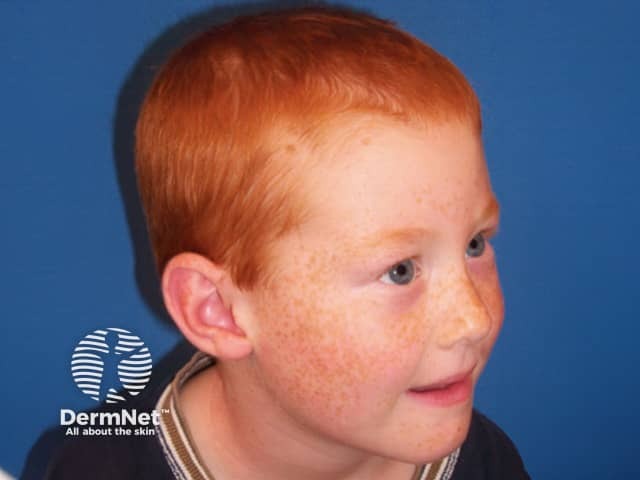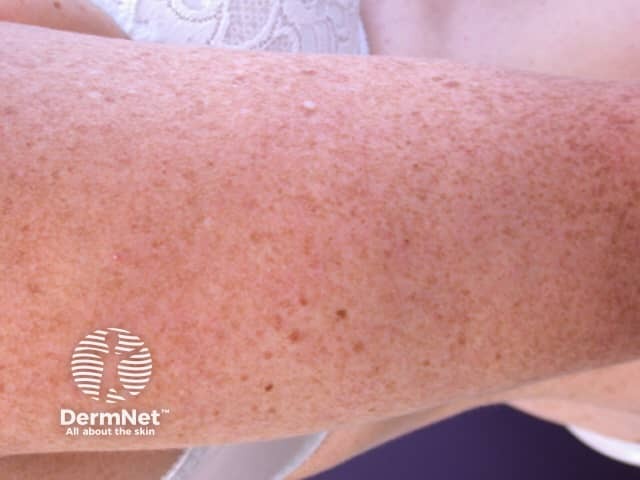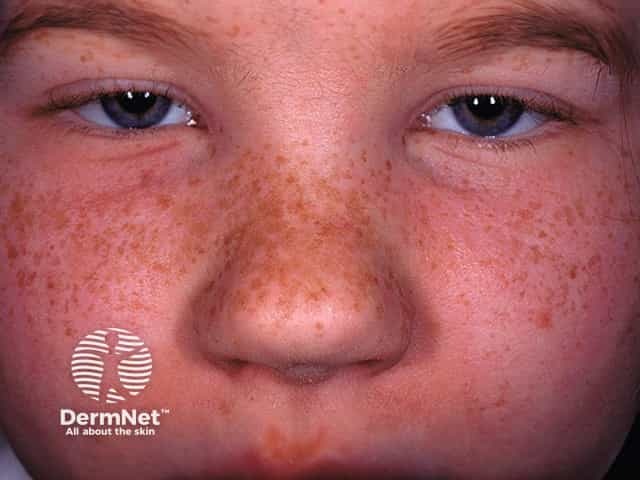Main menu
Common skin conditions

NEWS
Join DermNet PRO
Read more
Quick links
Ephelis — extra information
Ephelis
Author: A/Prof Amanda Oakley, Dermatologist, Hamilton, New Zealand, February 2016.
Introduction
Demographics
Causes
Clinical features
Complications
Diagnosis
Treatment
Prevention
Outlook
What is an ephelis?
An ephelis is a freckle, a small, light brown or tan mark on the skin.
The plural of ephelis is ephelides. The can be hundreds or thousands of them on exposed skin.
Who gets ephelides?
Ephelides are particularly common in fair-skinned Celtic children. They are not present at birth. People with white skin that cannot tan (Fitzpatrick skin phototype 1) often have red hair and numerous ephelides. Ephelides can also occur in other races that have dark brown or black hair.
What causes ephelides?
Ephelides are an inherited characteristic. People with many ephelides have at least one copy of a variant MC1R gene, which is the same variant that causes red hair. Freckles in non-Caucasians are associated with a different variant of the gene.
The pigment-forming cells, melanocytes, produce more pigment than usual in ephelides. The pigment is packaged as melanosomes and distributed to surrounding keratinocytes.
Ephelides increase in number following exposure to ultraviolet radiation in sunlight.
What are the clinical features of ephelides?
Ephelides are found on sun-exposed sites, particularly the nose and cheeks.
- They are prominent during summer and fade during winter.
- Light to dark brown flat macules
- 3–10 mm in diameter
- Poorly defined and may merge into large patches
- Any shape; often round

Freckles

Freckles

Freckles
Complications of ephelides
People with ephelides are often fair skinned. Fair skin is prone to larger, sun-damage freckles called lentigines, as well as other signs of skin ageing including skin cancer.
How is an ephelis diagnosed?
Ephelides are usually diagnosed clinically. However, from time to time, the diagnosis is made by a histopathologist after skin biopsy of a pigmented lesion.
- An increase in pigment is noted in otherwise normal skin
- There is no increase in the number of melanocytes (unlike lentigines)
What is the treatment for ephelides?
No treatment is necessary. Occasionally, people seek treatment for ephelides. They can be advised to protect affected areas using broad-spectrum, sun protection factor 50+ sunscreen.
- Cosmetic camouflage can be applied to disguise ephelides
- Pigment laser treatment may result in temporary lightening of the freckles
How can ephelides be prevented?
As they are an inherited characteristic, they cannot be prevented. However, the summer darkening can be reduced by careful sun protection.
What is the outlook for ephelides?
Ephelides are particularly prominent in children. They often become less obvious in adult life.
On DermNet
